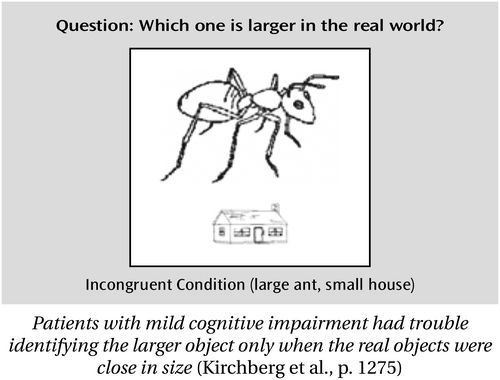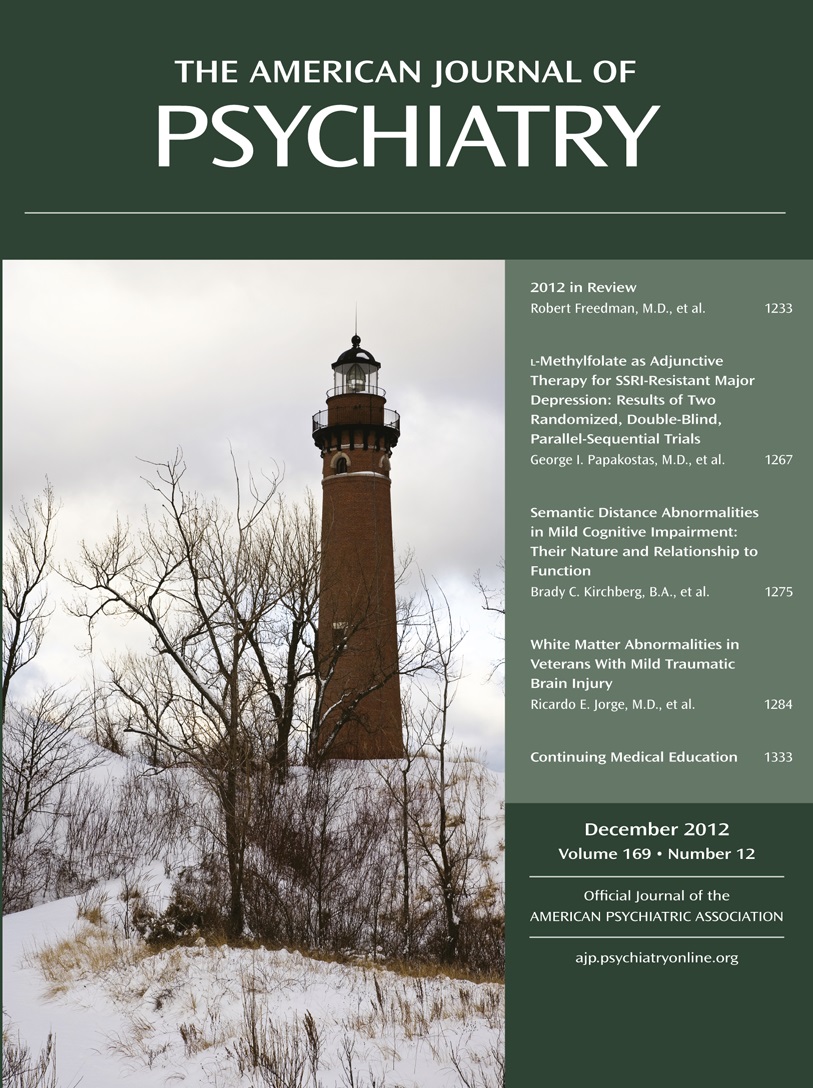In This Issue

Semantic Memory Deficit in Mild Cognitive Impairment
A test requiring judgments about size differences between objects represented by their names revealed that patients meeting criteria for amnestic mild cognitive impairment had problems in semantic memory that were independent of the ability to retrieve the words themselves. The problems were more pronounced for objects with small size differences. When the objects were represented by drawings, incongruity in the size of the objects (figure) had an undue influence on patients’ judgments. Kirchberg et al. (p. Original article: 1275) suggest that the findings indicate a degraded store of semantic knowledge, their general store of knowledge about the world. The semantic memory deficit was associated with functional impairment, and in an editorial Salmon (p. Original article: 1226) considers how a loss of semantic knowledge could contribute to a decline in judgment about financial and other important matters.
White Matter “Potholes” in Mild Traumatic Brain Injury
Brain locations showing disrupted white matter, or “potholes,” were more numerous in war veterans with mild traumatic brain injury (TBI) than in veterans without TBI, even though the groups did not differ significantly when they were compared across each brain region. Jorge et al. (CME, p. Original article: 1284) conclude that the brain damage due to TBI is diffuse and does not target specific brain regions. A higher number of potholes was associated with greater TBI severity and loss of ability to execute mental tasks. Civilians with TBI had even higher numbers of potholes than the veterans with TBI, but as Silver notes in an editorial (p. Original article: 1230), the civilians’ injuries were much more recent and abnormalities vary over time.
Patients with major depression who have an insufficient response to selective serotonin reuptake inhibitors (SSRIs) may benefit from the addition of 15 mg/day of l-methylfolate, the only form of folate that crosses the blood-brain barrier. Papakostas et al. (p. Original article: 1267) found that adding 7.5 mg/day was no more effective than adding placebo, but 15.0 mg/day plus ongoing SSRI treatment produced a 32% response rate, compared to 15% for augmentation with placebo. Side effects in the two groups were comparable in type and frequency. Nelson raises the issue of cost in an editorial (p. Original article: 1223), since l-methylfolate is classified as a medical food and is not covered by all insurance plans. Positive results have also been reported for adjunctive S-adenosyl methionine (SAMe) (Am J Psychiatry 2010; 167:942–948) and creatine (Am J Psychiatry 2012; 169:937–945). These over-the-counter supplements are also not covered by insurance but may provide alternatives to augmentation with an antipsychotic or lithium.
Electroconvulsive therapy (ECT) is often effective for severely depressed patients who have not responded to multiple medication trials or who are at imminent risk of suicide or other acute clinical condition. Kellner et al. (CME, p. Original article: 1238) highlight the safety and efficacy of ECT while stressing the importance of the pre-ECT medical evaluation and consent process. A common strategy is to start with right unilateral ECT, which produces less retrograde amnesia, and if it is ineffective, switch to bilateral electrode placement. Antidepressants may be continued during ECT and may augment the response. Psychotic or other severe symptoms do not ordinarily affect the capacity to provide fully informed consent, but a family member can often corroborate the patient’s history, help the patient understand information about ECT, and care for the patient during treatment. ECT practitioners should know the local legal requirements, which vary by state and are more complex for children and adolescents.



